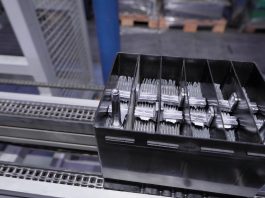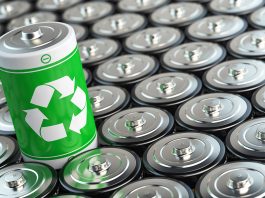Johan Söderbom, Thematic Leader for Smart Grids and Energy Storage at EIT InnoEnergy, outlines the importance of developing innovative battery chemistry to ensure that battery demand is met.
Already a 45 billion dollar business, today’s battery industry is forecast to treble to $135bn by 2031. Its growth over the last few years has been nothing short of spectacular. Back in 2017, there was very little planned battery capacity in Europe, but recognising the vital role that batteries play in tackling climate change, there are now at least 45 different battery projects in the works. The European Battery Alliance (EBA), led by EIT InnoEnergy, has been instrumental in much of this progress. Bringing together stakeholders from across the battery manufacturing value chain, the EBA is working to overcome Europe’s battery challenge from every angle – from roadmap development and financing to mining and skills. Now, the challenge is not so much about capacity, but about battery chemistry.
20 years ago, battery chemists hashed out the pros and cons of several major battery chemistries and ultimately opted to pursue lithium which has resulted in its superior energy density performance. It is a decision that has served the world well, until recently. Originally developed for small electronics such as cameras, nobody could have predicted such a large uplift in demand as a result of electric vehicles (EVs).
This surge in demand poses a challenge in ethically sourcing sufficient quantities of lithium, cobalt, and nickel. In fact, the IEA suggests that the world may face a potential shortage of lithium as early as 2025. As current EVs are exclusively designed for lithium chemistries, significant investments and resources are already being made to maximise the use of every unit of lithium while also improving capacity, charge and discharge speeds, and rates of degradation. However, over the next several years, it will be vital that alternative battery chemistries such as sodium-ion as well as improvement of the lithium-ion (Li-ion) family of batteries are pursued.
Commercialising sodium
Although the current battery chemistry for sodium technologies continues to trail lithium in terms of energy density, sodium is an abundant material which makes it ideal for stationary storage. Sodium-ion batteries have the potential to be an attractive alternative battery chemistry for entry-level EVs that will be on par in charge times but have a little shorter range in return for a lower price point.

An ‘AB battery solution’ that combines lithium and sodium cells into one battery pack could also be an attractive option to harvest the best of the two technologies. Enticed by the vast potential of sodium chemistries, industry giant CATL has already begun small-scale production, with mass volumes expected in 2023. And many smaller innovators are following suit.
Readying the supply chain for a surge in demand, Uppsala-based Altris has developed a high energy density cathode material it calls Fennac, which it manufactures from sodium, iron, carbon, and nitrogen. The technology has been developed to be able to plug and play into any industry-standard Li-ion production line. It is so innovative that it has caught the eye of world-leading battery developer Northvolt who took part in Altris’ Series A funding round. The €9.6m raised is being used to open a GWh scale production facility by late 2023.
Towards a 100% silicon battery chemistry
Silicon as an anode material is also on the rise. Silicon solutions are unique in that they can store vast amounts of Li-ions at rapid speeds, enabling charging speeds of under 15 minutes with over 500 miles of range. However, the industry faces several challenges in taking chemistries from the <10% silicon-graphite mix that we have today, to the potential 100% silicon chemistries that we could benefit from in the future. These challenges include creating a stable battery chemistry that will allow for silicon’s natural propensity to expand and contract as it charges and discharges and make it scalable at a cost-competitive price point. The industry is pursuing several strategies, some of which will follow a path of gradually increasing silicon content, while others are pushing to introduce full silicon anodes as early as 2027.
Working towards a fully silicon battery chemistry is a challenge that New York-based battery innovator GDI has spent the best part of the last decade working on to deliver. Taking inspiration from photovoltaic panels, GDI uses plasma-enhanced chemical vapour deposition to create a unique 100% silicon anode design. In laboratory tests, this battery chemistry has been proven to offer a 30% energy density increase on advanced Li-ion batteries by 30% as well as safe and reliable fast charging from 10-75% in 15 minutes over 500 times with a remaining 80% state of health.

Recognising Europe’s burgeoning market, GDI is one of several American start-ups that EIT InnoEnergy is helping to establish a foothold in Europe to bring global innovation to the benefit of European consumers. After completing a major Series A funding round in which GDI attracted $13.3m, it will now establish its first production line in Eindhoven, in the Netherlands, with support from European high-tech industrial companies AGC and Schlenk. Once the pilot production line has proved successful, the alliance aims to achieve 100 MWh of anode production capacity in 2024, 1 GWh in 2026, and 10 GWh by 2028.
Futureproofing the supply chain
20 years ago, industry made the misstep of pursuing certain battery chemistries without considering what the future might hold. We know better now. In December 2022, the European Parliament announced new circular economy legislation that stipulates requirements across a battery’s entire lifecycle. For example, it will require new batteries to use a minimum of 6% of recovered lithium and sets progressive targets for the collection of spent batteries.
The new legislation drives home the message that we must address our scrap. This includes reducing manufacturing waste, making it easier to understand the remaining health of a battery for potential reuse and easy disassembly for recycling. Current battery manufacturing practices still produce as much as 10%, even in well-tuned facilities. Innovators such as Verkor are tackling scrap by applying data and industrial digitalisation to bring forward a more modern and efficient Gigafactory model to meet future demand.
Similarly, although subsidiary supply chains are beginning to appear to handle the ‘black mass’ coming from recycled batteries, recycling volumes are low as a result of challenging logistics, poor labelling, and enormous variation in chemistries. We need many more companies to follow in the footsteps of industry leaders such as Northvolt which is constructing its first recycling facility in Sweden. Once operating at full capacity, it will handle 120,000 tonnes per year and be able to supply at least 50% of the raw materials required by its adjacent factory.
The next several years are critical for the development of a sustainable, indigenous supply of batteries for Europe. We need to rapidly develop new battery chemistries and new competences to not only tackle climate change but remain competitive while doing so. We are fortunate to boast many innovative battery projects in Europe, but it remains vital that the industry has access to sufficient capital and collaboration opportunities to meet growing demands.

Johan Söderbom
Thematic Leader for Smart Grids and Energy Storage
EIT InnoEnergy
https://www.innoenergy.com/
https://www.linkedin.com/in/johan-s%C3%B6derbom-a84b652a/?originalSubdomain=se
Please note, this article will also appear in the thirteenth edition of our quarterly publication.









